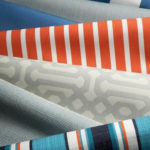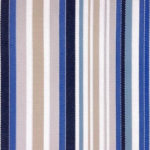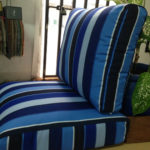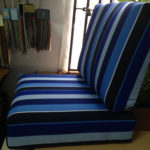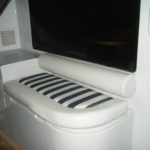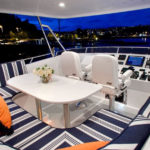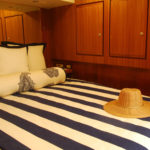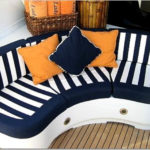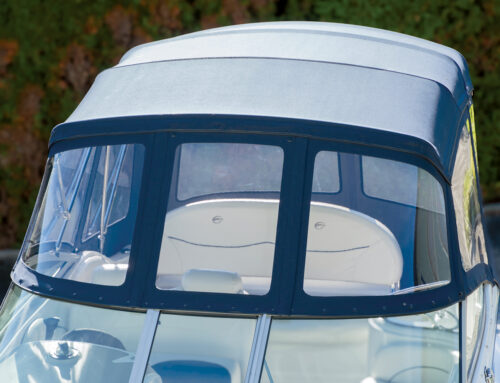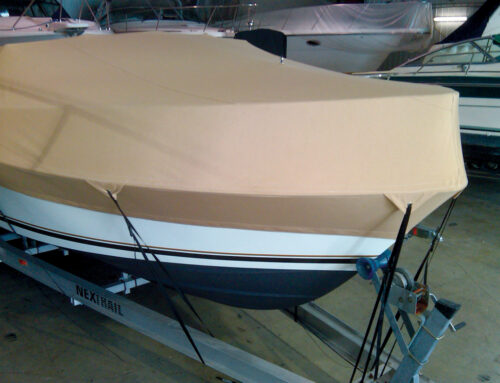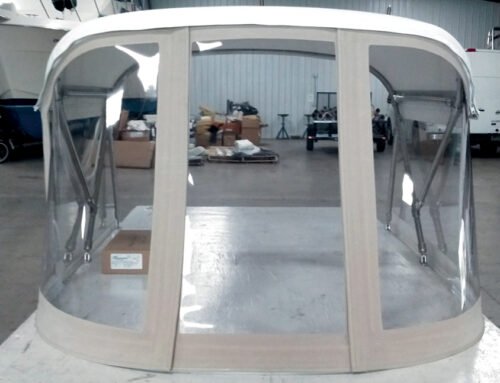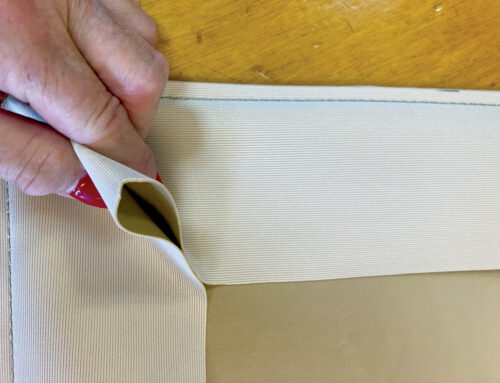Elegant performance in stripes
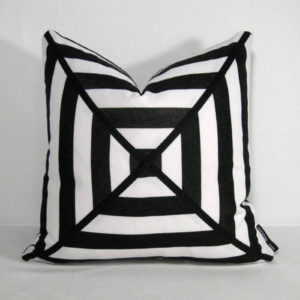 Stripes come in every color, shape and size. A two-color stripe can even be juxtaposed to form an eye-catching pattern. Striking stripe patterns can be matched or combined with solid colors to provide dramatic effects for your next project. Stripes are more popular than ever.
Stripes come in every color, shape and size. A two-color stripe can even be juxtaposed to form an eye-catching pattern. Striking stripe patterns can be matched or combined with solid colors to provide dramatic effects for your next project. Stripes are more popular than ever.
Sunbrella likes them so much, subtle as well as dramatic stripes are featured in the company’s 2016-2017 Upholstery Fabric Brochure. Stripes can be placed horizontally or vertically to give a low and wide effect versus a high or tall dimension to a space. As marine fabricators, we even get to play with stripes around curved edges and contour corners. The sky is the limit, yet we need to apply some earthly planning to ensure that incorporating stripes into a project is a winning solution.
Every year new patterns and colors are developed that invite fabricators to create different looks onboard a yacht—classic, modern, chic or sophisticated. A sailor stripe sets off an eye-catching look, especially when combined alongside various shades of brilliant oranges, or you can offer a subtle pallet of clay and charcoal that is a modern interpretation of European-inspired designs with architectural precision.
If you’re not familiar with fabricating with stripes, it can be a bit of a challenge. But welcome the opportunity—stripes are synonymous with boat décor and make a dramatic nautical impact on any yacht. And your choices of colors and sizes are virtually endless. I was a bit daunted as to how to proceed for a few of the projects and spaces that will be explained and illustrated in this article. I want to give you that “step-ahead” when your next customer inquires and selects a striped marine textile for his or her boat. Here are some essential design elements to consider:
Repeat of a fabric. The “repeat” of a fabric refers to the number of inches it takes before the pattern starts all over again. It is the distance between the starting point of the pattern to the point at which the pattern starts over again. This is referred to as “one repeat.”
When choosing a fabric for a project, it is important to know the repeat of the pattern you are considering. The repeat can have a big impact on how much fabric you need, and what that product looks like on a sectional seating with multiple cushions compared to a single cushion.
Any type of patterned fabric will have a repeat, and the supplier generally provides this information.
The average repeats size of a stripe is between 8 and 9 inches. A cushion layout needs to be planned ahead of time to order the correct quantity of fabric as well as the best use of the material.
We recently provided a few colorways to a customer in a handsome nautical stripe. We received two swatches from a supplier of the nautical pattern (photo 3); one was a navy/white/tan colorway and the other was a teal/white/navy colorway. The customer selected the navy/white/tan option, and when we went to order the material we were told that the pattern repeat was 16 inches. Ironically, the teal/white/navy colorway was a continuation of the navy/white/tan colorway, yet with several more white stripes, which our customer did not want. Additionally, the 16-inch repeat would have been extremely difficult to pattern as well as presenting a significant amount of fabric waste for matching cushions that would sit side by side. Image (3) shows two swatches sewn together to show the full repeat.
Also, it is always wise to have your customer select not only their first choice of material for a project, but also a second choice because time lost between selecting fabric, confirmation and ordering materials might result in the customer’s initial choice not being readily available.
Location. Determine the cushion(s) placement. Will it be side-by-side? Will there be a corner cushion that joins next to other cushions to form an L-seating area?
Cushion design. What will be the cushion’s style? Common types are rollover designs with side bands, rollover designs with corner seams, rollover designs with baseball corners, side bands in a contrasting stripe placement and side bands in a solid matching fabric.
If the cushion is a banded cushion, you have three options:
Vertical stripes. The contrast of a horizontal band to a vertical stripe on the band of the cushion actually can work nicely depending on the stripe.
Vertical vs. horizontal bands. When the face of the back cushion runs vertically, your seat cushion stripes must be patterned so that the stripes match perfectly. A piping accent may be used to enhance the construction transition to a side band in the horizontal or vertical direction. Consistency should be your guide for all cushions.
Solid color band. This can be your best option whether you are just starting to work with stripes, or are an experienced fabricator. A solid border and band work nicely when you have a contour corner area to fabricate.
It is wise to photograph the entire area where the cushions will be located and then sketch or draft examples over the area for consideration to determine the best option for your material direction, project space and a budget when you are estimating time and cost. Project planning, layout and construction time can easily add up when multiple pieces are part of a large layout (7).
I’m including a few photos of our projects as well as some interesting others that illustrate the variations I’ve explained. Look around and notice the placement of stripes on cushions and pillows whenever you see them in a residential, commercial or marine project. Trust your instinct, as to what works best or do a mock-up to guarantee a winning combination.
In the seating images (10, 11), I am certain someone spent a significant amount of time planning and fabricating these striped seat cushions. The side band makes a nice transition on the double seat with a baseball corner. The solid piping provides a clean transition to the stripe in the horizontal direction on the double seat.
However, I imagine we could all enjoy contemplating the various solutions as to our best shot for the corner cushion when a rollover design with this stripe was planned for the multiple seating on this yacht.
Send along your thoughts, ideas and any photos you have for a similar project that you have encountered. I’m interested and welcome your input.
May you enjoy “smooth sailing” into spring!
Terri Madden owns Sand Sea & Air Interiors Inc. in San Juan, Puerto Rico.
-

- Every year new patterns and colors are developed that invite fabricators to create different looks onboard a yacht.
-
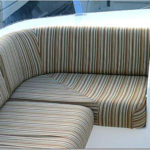
- 10. Baseball corners, solid piping and horizontal side bands all play a role in pulling together complicated stripe matching.
-
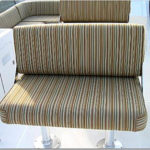
- 11. Baseball corners, solid piping and horizontal side bands all play a role in pulling together complicated stripe matching.
 TEXTILES.ORG
TEXTILES.ORG 


